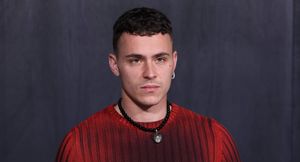When the pilot for Jill Soloway's new Amazon streaming series, Transparent, became available last April, I watched with both excitement and trepidation. For those of us who study and write about the politics of transgender representation, the past year has been an embarrassment of riches.
Positive images of transgender women have been circulating at unprecedented levels: Janet Mock, Laverne Cox, Laura Jane Grace, Lana Wachowski, and Erika Ervin have all emerged as important media representatives for transgender people. Given the staggering discrimination, violence, and underemployment trans women face, it is absolutely necessary that trans women's issues and stories begin to be addressed.
But there has been an accompanying trend few have seemed to notice: The increased visibility for trans women has not necessarily meant increased visibility for transgender men. True, there is a more concerted need to correct a history of negative media stereotypes about trans women. Our culture's ingrained transmisogyny has meant that trans women have been more targeted for media exploitation.
However, while trans men do not face the same levels of hostility and violence, we have also been more invisible.
Historically, representations of transmasculine people have always been more scarce, and today's visual media is no different. Boys Don't Cry is now 15 years old. The L Word ended five years ago. Adam Torres, a trans male character on Degrassi: The Next Generation, was killed off last year. All three media products were either poorly written or politically problematic, featuring cisgender (nontrans) female actors playing the trans male roles.
Trans men of color fare even worse: Representations of their lives in scripted media are nonexistent. Infrequently, there is a glimmer of hope: Tom Phelan, who identifies as nonbinary -- neither male nor female -- plays a character on The Fosters who may indeed be the first transmasculine scripted character played by a trans actor. But the character, Cole, is secondary and sees little screen time.
The announcement that Amazon picked up Transparent for a full season left me thrilled. For the first time, a trans female character would be at the center of a scripted television series. Nonetheless, I wondered, would it include trans men's stories? If representations of transgender people in the media are indeed improving, then why isn't there room for more of us?
So imagine my surprise and delight when, watching Transparent episodes 6 and 7, trans man and comedian Ian Harvie appeared on my screen. Why hadn't I known that Harvie had been cast as an out trans man actually playing a trans man on scripted American television?
Because no one noticed.
As glossy and highly discussed as Transparent is, its main plot certainly isn't new. Yes, it gains new levels of exposure and empathy for transgender experience, but the show isn't groundbreaking in its portrayal of a later-in-life, middle-class, white trans woman's story -- subject matter that should be familiar to anyone who has seen Normal or Transamerica.
Most of the discussion of Transparent in its first season has circulated around creator Soloway's decision to cast cisgender male actor Jeffrey Tambor in the lead transgender role. Soloway appears to have headed off much of the criticism that Dallas Buyers Club received by educating herself and her cast on trans issues and offering production jobs and speaking parts to actual trans people. For the most part, Soloway seems to have gotten trans representation "right," or at least, politically correct. Transparent is a media product that liberal American viewers and critics can feel good about.
But for me, what makes Transparent's first season truly exciting isn't its main storyline, and what makes the show specifically problematic isn't its casting of a cisgender man as a transgender woman. Neither is new. What Transparent attempts that feels totally new, it also ends up spectacularly failing at: telling transgender men's stories.
For a transgender man like me, seeing Ian Harvie on screen, depicted as dateable and sexually desirable, was electrifying. Yes, Harvie meets the standards of traditional white manhood, and therefore represents the most privileged form of transgender masculinity. Nonetheless, here was a trans man on-screen, with scripted lines, without all the emotional instability and tragic frustration that has traditionally been attached to trans masculine characters.
Imagine my subsequent disappointment when Harvie's entire storyline devolves into a series of jokes about this lack of a proper, cisgender penis. "I'm a man with a vag," his character says in one of his first lines on-screen. And that, unfortunately, is all Transparent is capable of letting trans men be.
Throughout the two episodes featuring Harvie, his character rapidly becomes a fetish that reflects some of the most negative stereotypes about trans men: That we're open to discussing our genitals with strangers, that we all view ourselves as "men with vaginas," that the only reason anyone would want to sleep with us is out of curiosity, that we exist to fulfill others' sexual fantasies of experimenting with "safe" masculinity, and that we're ultimately sexually defective because we do not have "normal" penises.
This final point is driven home in a bathroom scene in which Harvie's character attempts to penetrate Ali (Gaby Hoffman) with a prosthetic penis but loses his grip and drops it on the floor. This is played for laughs, but for people who experience genital dysphoria, it can easily translate as an awful, shaming scene in which Harvie is revealed to be "less than" a man. The encounter leaves both parties visibly frustrated and unsatisfied. The scene seems to insist that we, the audience, view Harvie as dickless and therefore deficient, despite the fact that many trans men either have penises or view them as inessential to their maleness.
After the encounter in the bathroom, the entire representation of Harvie's character as heterosexually desirable is revealed to be a delusion, his character existing only to supply Ali with an erotic fantasy. While the show may attempt to present this fantasy critically, its treatment of the trans male character remains the same: a prop in someone else's imagination.
Compare this to Transparent's tasteful and respectful treatment of Maura, whose genitals are never once mentioned, and you begin to see a major contrast in the show's treatment of trans men and women. Objectification, fetishization, and obsession with genitals that all feed transphobia are still present in Transparent -- but they are directed away from trans women and toward trans men. Certainly, this is not the kind of representation that most trans men are hoping for.
 CAEL KEEGAN is assistant professor of women and gender studies/liberal studies at Grand Valley State University in Allendale, Mich. His teaching and writing are concentrated on LGBTQ history, representation, and movement politics, with specializations in transgender studies and the popular moving image. His current book project is a study of the cultural impact and political relevance of Lana Wachowski's filmography.
CAEL KEEGAN is assistant professor of women and gender studies/liberal studies at Grand Valley State University in Allendale, Mich. His teaching and writing are concentrated on LGBTQ history, representation, and movement politics, with specializations in transgender studies and the popular moving image. His current book project is a study of the cultural impact and political relevance of Lana Wachowski's filmography.


 CAEL KEEGAN is assistant professor of women and gender studies/liberal studies at Grand Valley State University in Allendale, Mich. His teaching and writing are concentrated on LGBTQ history, representation, and movement politics, with specializations in transgender studies and the popular moving image. His current book project is a study of the cultural impact and political relevance of Lana Wachowski's filmography.
CAEL KEEGAN is assistant professor of women and gender studies/liberal studies at Grand Valley State University in Allendale, Mich. His teaching and writing are concentrated on LGBTQ history, representation, and movement politics, with specializations in transgender studies and the popular moving image. His current book project is a study of the cultural impact and political relevance of Lana Wachowski's filmography.

































































Charlie Kirk DID say stoning gay people was the 'perfect law' — and these other heinous quotes